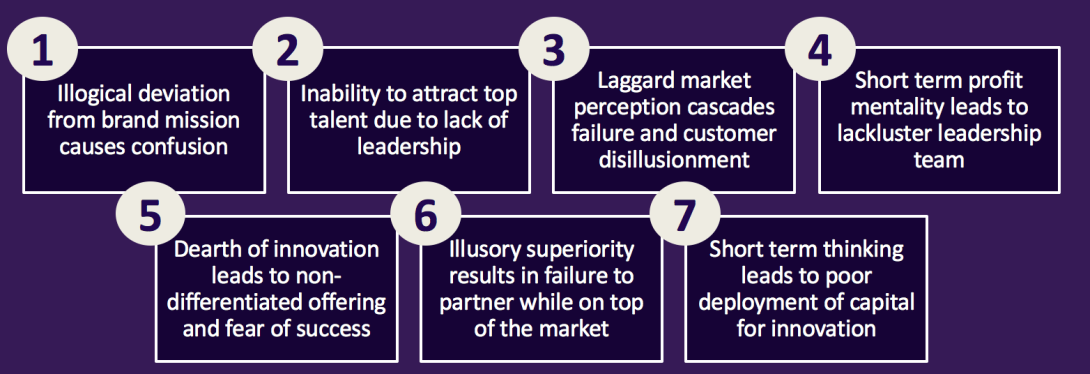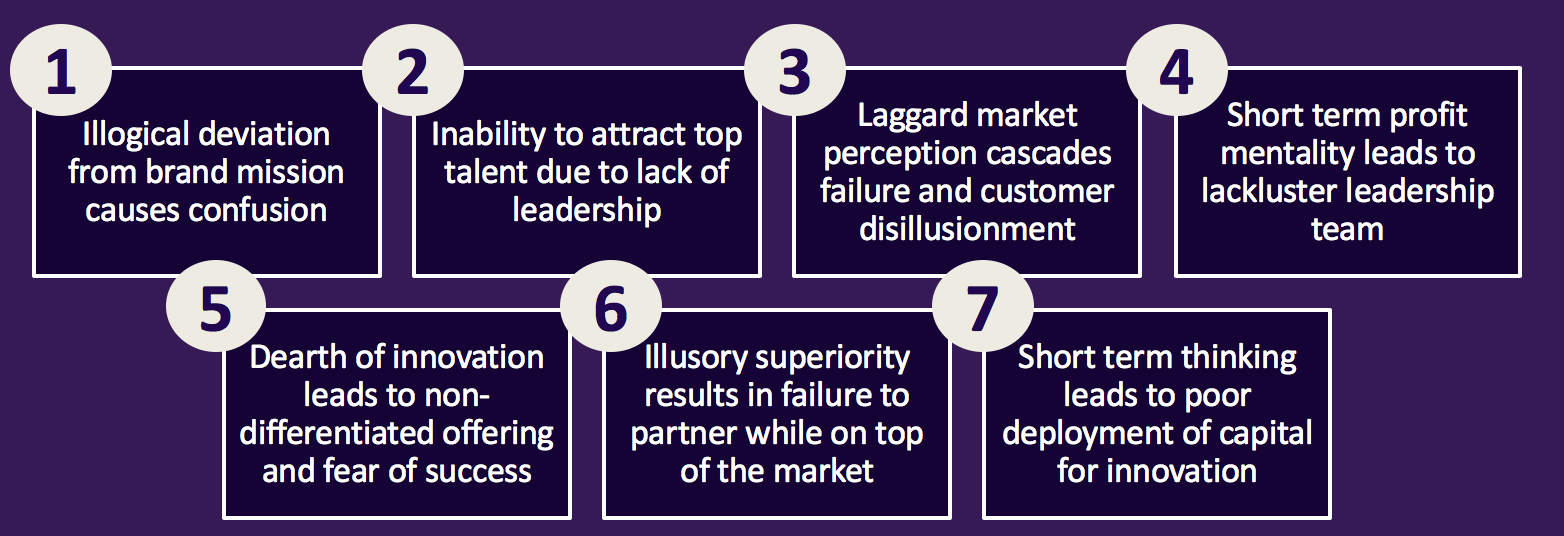
Monday's Musings: Seven Common Failures Plague Board Room Strategy In Digital Transformation
Boardroom Failures Reflect Years Of Focus On EBIDTA and Return On Capital
Faced with massive pressure to embark on their digital journey, boards and CEOs have sought case studies and examples of success to avail without realizing that each journey remains unique. While there are many proof of concepts in play, much of the innovation in play requires a transformational mindset. When boards ask, “Has this has been done before and where”, they miss the point. Why? The task at hand requires a shift from operational efficiency or regulatory compliance to a revenue growth and strategic transformation mind set. Over a decade of digital transformation experience has shown that seven factors create mass board failures in digital transformation (see Figure 1):
Figure 1. Seven Common Boardroom Issues With Digital Transformation

- Illogical deviation from brand mission causes confusion. While the brand mission can be expanded to a higher order, failure often arises when the brand attempts to solve a problem that the existing customer base finds too deviant. For example, Avis Rental Car has a stated mission to move from rental car company to fleet management. This is a shift from a transactional consumer relationship to an experiential B2B and outcomes based relationship based on their data driven skill of fleet management. Customers find this a reasonable extension. However, If an apparel brand jumped into a new space such as fast food without explaining a larger shift in their mission, that deviation would be too much.
- Inability to attract top talent due to lack of leadership. Top talent attracts top talent. A players attract A players. B players attract C players. Tech companies in the midst of transformation know how to sell their company’s higher mission to recruit top talent seeking a higher purpose. For years, Salesforce.com CEO Marc Benioff sold a vision of no software that appealed to the tech community looking to transform the software business model. Today, his appeal on “tech for good” attracts the best and brightest. The founders of Ultimate Software started out with a People First mission that has stood the test of time. Meanwhile another large tech company has had years of a CEO who has failed to not only attract top talent, but also has failed to retain top talent by creating an environment of instability and insecurity across the ranks as that CEO enriches themselves despite a string of quarterly losses. Change in workforce policies disguised as a reduction in force and the promotion of unqualified individuals under the guise of diversity and inclusion have stripped the ranks of any sense of meritocracy and led to a brain drain that will require a new CEO to arrive prior to that CEO’s retirement this year.
- Laggard market perception cascades failure and customer disillusionment. Declining brands and organizations in laggard industries stripped of brand equity enter an era of negative market perception. Instead of redefining the mission and purpose with new business models, orgs often take a short cut of branding without substance. Seen as devoid of innovation with a commoditized non-differentiated offering, every stakeholder from employee, customer, partner, supplier, and investor lowers expectations of success. The result – leaders who focus on short term gain, declining employee morale, lack of interest by investors, and lower quality from suppliers. Partners lose interest in creating co-innovation and co-creation ecosystems with laggards. Customers no longer find an affinity for a brand that has sold its soul and will not pay for premium pricing when they no longer see value.
- Short term profit mentality leads to lackluster leadership team. Modern leaders must be able to not only articulate the vision and mission, but also live the values of the organization. Leaders use stories and authentic purpose to attract the right talent. However, the battering of hostile take overs and transformation by fake growth based private equity (PE) firms focused on greater amounts of EBITDA have led to a generation of “Yes Person” CEOs without an understanding of growth. A focus on standard operating practices that focus on efficiency and not growth creates anorexic innovation environments. The definitiveness of cost cut impacts to growing share price result in leadership teams devoid of leaders who know how to create a culture of sustained innovation and long-term growth. This driving out of innovation and growth hurts organizations in the long-run.
- Dearth of innovation leads to non-differentiated offering and fear of success. Nothing wreaks of failure more than the copycat offering that arrives a cycle late in the marketplace. Organizations who are just doing the bare minimum and rationalizing their product portfolios often have had the EBIDTA militants and legal teams dictate product direction. One can argue that playing it safe and riding on the remaining vestiges of brand cache can help a short term CEO and board hit their targets. Yet this leaves an organization without any differentiation and creates a long term hit. The US auto industry in the 1980s provides a great case study on how not to ruin a market entered by low cost challengers. If the goal is to be the most profitable copycat in the industry, that game has already ended in commoditized markets where the battle for return on equity leaves few players battling a digital death match with no winners. To be clear, there are exceptions. Korean electronics firms for a period of time managed to take innovations from the Japanese and build bigger and profitable challenges. But over time, they also realized they had to commit to innovation in order to not only grow but survive market annihilation.
- Illusory superiority results in failure to partner while on top of the market. Delusions of grandeur and ego often beset successful market leaders. Thinking that their organization knows best and that others have little to offer create a divide the pie mentality that stifles grow the pie growth and transformation efforts. The result – arrogant partner policies, poor treatment of the ecosystem, and disregard for new adjacent opportunities. As egos take over rationality, a belief that the organization can create whatever a partner has to offer results in a cognitive bias and failure to understand limitations and capabilities. Blackberry’s dominance in the 2000’s came to a standstill as their failure to tap into the partner ecosystem reflected their overall market and leadership hubris as the management team could not believe they could be displaced by Apple’s toy which didn’t even have a physical keyboard. Today, one may question whether Apple still has the innovation chops to survive despite crushing it on EBIDTA and return on capital.
- Short term thinking leads to poor deployment of capital for innovation. Decades of cost cutting, mergers and acquisitions, and activist shareholder fights have decimated the growth and innovation culture at many organizations. In a graph often cited from Clay Christensen, the average investment of profits in 1981 was 50% allocated to research and development and 50% to shareholder dividends. Today that investment number is allocated to 50% stock buy backs, 49% dividends, and 1% research and development (see Figure 2). This strangulation of capital funding for innovation has decimated legacy enterprises.
Jump Start Growth By Re-prioritizing Focus Areas
Over the next few months, Constellation will provide a model for helping boards and CXO's understand where they sit in the continuum of growth and innovation. Five focus areas will emerge that boards and CXO's should consider in their digital transformation efforts to ensure success. Stay tuned for more.
Your POV.
Ready to roll out your plans for digital transformation. Do you understand the business model implications? Are you ready to disrupt the board and jump start growth? Add your comments to the blog or reach me via email: R (at) ConstellationR (dot) com or R (at) SoftwareInsider (dot) org.
- Developing your digital business strategy
- Connecting with other pioneers
- Sharing best practices
- Vendor selection
- Implementation partner selection
- Providing contract negotiations and software licensing support
- Demystifying software licensing
Reprints can be purchased through Constellation Research, Inc. To request official reprints in PDF format, please contact Sales .
Resources And Related Research
Monday’s Musings: Designing Five Pillars For Level 1 Artificial Intelligence Ethics March 26, 2018
Research Report: Constellation’s Futurist Framework (PESTEL) – The Societal Outlook Pre @Davos #WEF18 January 18, 2018
Research Report: Constellation’s Futurist Framework (PESTEL) – The Economic Outlook Pre @Davos #WEF18 January 17, 2018
Research Report: Constellation’s Futurist Framework (PESTEL) – The Political Outlook Pre @Davos #WEF18 January 16, 2018
Monday’s Musings: Want AI Ethics? Learn From These Four Movies/TV Shows!December 3, 2017
Research Report: Demystifying Artificial IntelligenceNovember 16, 2017
Monday’s Musing: Infinite Ambient Orchestration November 6, 2017
Tuesday’s Tip: Know When To Automate With Artificial Intelligence September 19, 2017
Personal Log: Congratulations To Constellation’s BT-150 Winners #BT150 September 6, 2017
Research Summary: Constellation ShortList™ Integration Platform as a Service (IPaaS) August 13, 2017
Research Summary: Constellation ShortList™ Synchronous Ledger and Blockchain Platforms August 13, 2017
Research Summary: The Future of Customer Experience (CX) is Orchestrated Engagement June 15, 2017
Research Summary: Nine Starting Points For Digital Transformation In Manufacturing May 10, 2017
Research Summary: Artificial Intelligence Delivers Mass Personalization In Commerce April 17, 2017
Tuesday’s Tip: Seven Universal Factors Why Technology Firms Fail January 10, 2017
Monday’s Musings: Dynamic Leadership – A Responsive And Responsible Approach #Davos17 #WEF
News Analysis: In Search Of Growth Amidst Digital Disruption
Event Report: The Weekend Before Davos And The Dawn Of The Fourth Industrial Revolution
Event Report: The Future Of Jobs From #Davos16 #WEF
Event Report: The Transformation of Finance #Davos16 #WEF
Event Report: A New Platform For The Digital Economy #Davos16 #WEF
Monday’s Musings: Secrets Behind Building Any AI Driven Smart Service November 28, 2016
Trends: Five Data Center Trends For 2017 November 12, 2016
News Analysis: America In An @RealDonaldTrump Era – Everything International Clients Need To Know PESTEL Part 1. November 10, 2016
Research Summary: Constellation’s AstroChart For Business Trends, Q4 2016 October 18, 2016
Research Summary: Constellation’s AstroChart For Tech Trends October 17, 2016
Monday’s Musings: Secrets Behind Building Any AI Driven Smart Service
Monday’s Musings: Understand The Spectrum Of Seven Artificial Intelligence Outcomes
Tuesday’s Tip: Seven Factors For Precision Decisions In Artificial Intelligence
Monday’s Musings: Data – The Foundation Of Real-Time Digital Business
‘Monday’s Musings: Who Gets To Be A Chief Digital Officer?
Monday’s Musings: CXOs Seek Enterprise-Grade Mobile Solutions Despite Seven Barriers August 16, 2016
Research Summary: [VIDEO] Inside Constellation’s Futurist Framework August 9, 2016
Best Practices: Five Critical Success Factors To Digital Transformation July 10, 2016
Monday’s Musings: Data – The Foundation Of Real-Time Digital Business May 23, 2016
Monday’s Musings: Why Digital Transformation Must Move Beyond The Hiring Of A Chief Digital Officer April 25, 2016
Monday’s Musings: The Four Personas Of The Modern CMO In A Digital World April 11, 2016
Monday’s Musings: The Seven Rules For Digital Business And Digital Transformation
Tuesday’s Tip: Five Steps To Starting Your Digital Transformation Initiative
Research Summary: Economic Trends Exacerbate Digital Business Disruption And Digital Transformation (The Futurist Framework Part 3)
Research Summary: Five Societal Shifts Showcase The Digital Divide Ahead (The Futurist Framework Part 2)
Research Summary: Sneak Peaks From Constellation’s Futurist Framework And 2014 Outlook On Digital Disruption
Research Report: Digital ARTISANs – The Seven Building Blocks Behind Building A Digital Business DNA
Research Summary: Five Societal Shifts Showcase The Digital Divide Ahead (The Futurist Framework Part 2)
Research Summary: Next Generation CIOs Aspire To Focus More On Innovation And The Chief Digital Officer Role
Trends: [VIDEO] The Digital Business Disruption Ahead Preview – NASSCOM India Leadership Forum (#NASSCOM_ILF)
Harvard Business Review: What a Big Data Business Model Looks Like
Monday’s Musings: How The Five Consumer Tech Macro Pillars Influence Enterprise Software Innovation
Tuesday’s Tip: Understand The Five Generation Of Digital Workers And Customers
Monday’s Musings: The Chief Digital Officer In The Age Of Digital Business
Slide Share: The CMO vs CIO – Pathways To Collaboration
Research Summary And Speaker Notes: The Identity Manifesto – Why Identity Is At The Heart of Digital Business
Disclosure
Although we work closely with many mega software vendors, we want you to trust us. For the full disclosure policy,stay tuned for the full client list on the Constellation Research website. * Not responsible for any factual errors or omissions. However, happy to correct any errors upon email receipt.
Copyright © 2001 – 2018 R Wang and Insider Associates, LLC All rights reserved.
Contact the Sales team to purchase this report on a a la carte basis or join the Constellation Executive Network
 R "Ray" Wang
R "Ray" Wang R "Ray" Wang
R "Ray" Wang